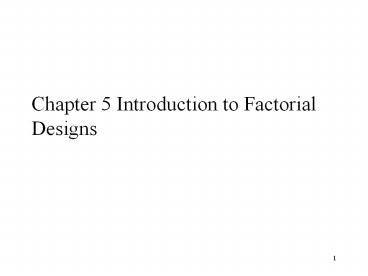Chapter 5 Introduction to Factorial Designs PowerPoint PPT Presentation
Title: Chapter 5 Introduction to Factorial Designs
1
Chapter 5 Introduction to Factorial Designs
2
5.1 Basic Definitions and Principles
- Study the effects of two or more factors.
- Factorial designs
- Crossed factors are arranged in a factorial
design - Main effect the change in response produced by a
change in the level of the factor
3
Definition of a factor effect The change in the
mean response when the factor is changed from low
to high
4
(No Transcript)
5
Regression Model The Associated Response Surface
6
The Effect of Interaction on the Response Surface
Suppose that we add an interaction term to the
model
Interaction is actually a form of curvature
7
- When an interaction is large, the corresponding
main effects have little practical meaning. - A significant interaction will often mask the
significance of main effects.
8
5.3 The Two-Factor Factorial Design
- 5.3.1 An Example
- a levels for factor A, b levels for factor B and
n replicates - Design a battery the plate materials (3 levels)
v.s. temperatures (3 levels), and n 4 - Two questions
- What effects do material type and temperature
have on the life of the battery? - Is there a choice of material that would give
uniformly long life regardless of temperature?
9
- The data for the Battery Design
10
- Completely randomized design a levels of factor
A, b levels of factor B, n replicates
11
- Statistical (effects) model
- Testing hypotheses
12
- 5.3.2 Statistical Analysis of the Fixed Effects
Model
13
- Mean squares
14
- The ANOVA table
- See Page 180
- Example 5.1
15
Response Life ANOVA for Selected
Factorial Model Analysis of variance table
Partial sum of squares Sum of
Mean F Source Squares
DF Square Value Prob gt F Model
59416.22 8 7427.03 11.00 lt 0.0001 A
10683.72 2 5341.86 7.91 0.0020 B
39118.72 2 19559.36 28.97 lt
0.0001 AB 9613.78 4 2403.44 3.56
0.0186 Pure E 18230.75 27
675.21 C Total 77646.97 35 Std.
Dev. 25.98 R-Squared 0.7652 Mean 105.53 Adj
R-Squared 0.6956 C.V. 24.62 Pred
R-Squared 0.5826 PRESS 32410.22 Adeq
Precision 8.178
16
(No Transcript)
17
- Multiple Comparisons
- Use the methods in Chapter 3.
- Since the interaction is significant, fix the
factor B at a specific level and apply Turkeys
test to the means of factor A at this level. - See Pages 182, 183
- Compare all ab cells means to determine which one
differ significantly
18
- 5.3.3 Model Adequacy Checking
- Residual analysis
19
(No Transcript)
20
(No Transcript)
21
- 5.3.4 Estimating the Model Parameters
- The model is
- The normal equations
- Constraints
22
- Estimations
- The fitted value
- Choice of sample size Use OC curves to choose
the proper sample size.
23
- Consider a two-factor model without interaction
- Table 5.8
- The fitted values
- Figure 5.15
- One observation per cell
- The error variance is not estimable because the
two-factor interaction and the error can not be
separated. - Assume no interaction. (Table 5.9)
- Tukey (1949) assume (??)ij r?i?j (Page 192)
- Example 5.2
24
5.4 The General Factorial Design
- More than two factors a levels of factor A, b
levels of factor B, c levels of factor C, , and
n replicates. - Total abc n observations.
- For a fixed effects model, test statistics for
each main effect and interaction may be
constructed by dividing the corresponding mean
square for effect or interaction by the mean
square error.
25
- Degree of freedom
- Main effect of levels 1
- Interaction the product of the of degrees of
freedom associated with the individual components
of the interaction. - The three factor analysis of variance model
- The ANOVA table (see Table 5.12)
- Computing formulas for the sums of squares (see
Page 196) - Example 5.3
26
5.5 Fitting Response Curves and Surfaces
- An equation relates the response (y) to the
factor (x). - Useful for interpolation.
- Linear regression methods
- Example 5.4
- Study how temperatures affects the battery life
- Hierarchy principle
- Example 5.5
27
5.6 Blocking in a Factorial Design
- A nuisance factor blocking
- A single replicate of a complete factorial
experiment is run within each block. - Model
- No interaction between blocks and treatments
- ANOVA table (Table 5.18)
- Example 5.6
28
- Two randomization restrictions Latin square
design - An example in Page 209
- Model
- Table 5.22

